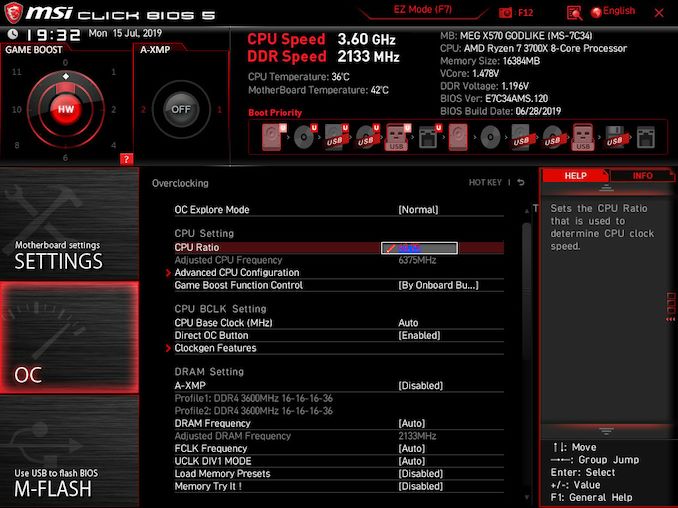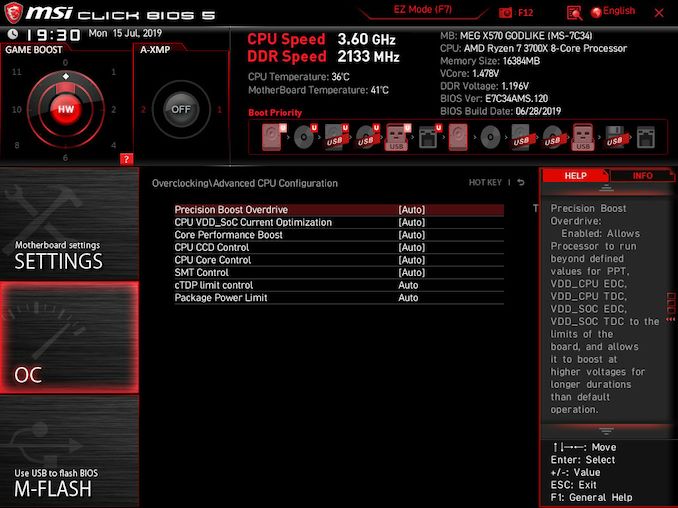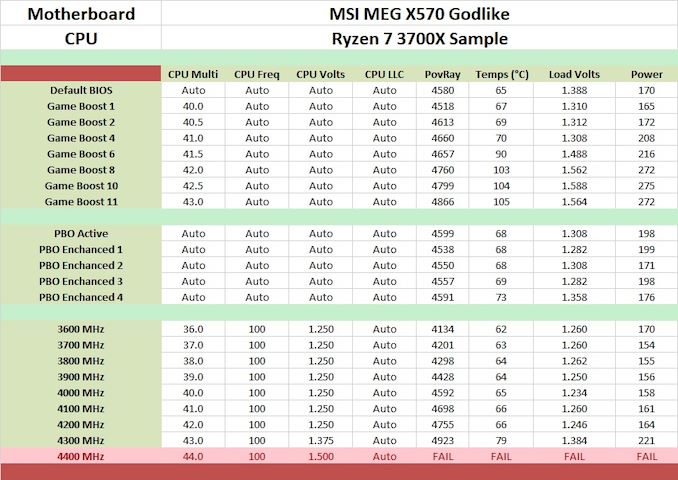The MSI MEG X570 Godlike Motherboard Review: Thor's Flagship
by Gavin Bonshor on August 28, 2019 12:00 PM EST- Posted in
- Motherboards
- AMD
- MSI
- 10G Ethernet
- Ryzen
- PCIe 4.0
- Ryzen 3000
- X570
- X570 Godlike
- MEG
Overclocking Ryzen 3000
Experience with the MSI MEG X570 Godlike
Overclocking with the Ryzen 3000 series hasn't exactly titillated users since its launch with there not being much headroom available. The biggest issue with this boils down to all-core overclocks being limited by the worst core of the chip. and the new 7 nm processors running quite warm. To get the best experience and results with the Ryzen 3000, users with good quality AIOs and custom water cooling yields the best outcome, and even with voltages of 1.375 V, these chips can run a little too warm for comfort.
The MSI Click BIOS 5 firmware is familiar to us and throughout the different chipsets including X399, X470, and Z390, the MSI MEG X570 Godlike uses the same design layout and setup. Within the OC section of the firmware, users can alter important settings such as the CPU ratio which can be changed in steps of 0.25 MHz, with relevant settings including CPU VCore, CPU Base Clock, and even FCLK frequency. Deeper into the firmware is settings to set the load line calibration (LLC) to a more aggressive or liberal profile, as well as all the Precision Boost Overdrive (PBO) settings.
The three main settings that PBO works from include package power tracking (PPT), thermal design current (TDC), and the electrical design current (EDC). All three of these can be set within the firmware under the advanced section of the Precision Boost Overdrive menu, although MSI has included four different PBO profiles for users to select from. The higher the setting, the higher the thermal and power draw will be, and it may not necessarily matter if a sub-par cooler is installed; it's noted that Ryzen 3000 processors work better when they are cooler.
There are seven different MSI Game Boost profiles to select from and users can access them via the dial at the bottom of the board, or through the firmware itself. The Game Boost profiles within the firmware can be accessed through the dial in the top left-hand corner. These profiles range from 4.0 GHz through to 4.3 GHz, and we've tested each of them below.
Overclocking Methodology
Our standard overclocking methodology is as follows. We select the automatic overclock options and test for stability with POV-Ray and OCCT to simulate high-end workloads. These stability tests aim to catch any immediate causes for memory or CPU errors.
For manual overclocks, based on the information gathered from the previous testing, starts off at a nominal voltage and CPU multiplier, and the multiplier is increased until the stability tests are failed. The CPU voltage is increased gradually until the stability tests are passed, and the process repeated until the motherboard reduces the multiplier automatically (due to safety protocol) or the CPU temperature reaches a stupidly high level (105ºC+). Our testbed is not in a case, which should push overclocks higher with fresher (cooler) air.
Overclocking Results
As it currently stands, MSI's Game Boost overclocking profiles need quite a bit of refinement, something they have informed us that these will be rectified with a new firmware revision; we will test this when we receive the board back from MSI. The issue with these is CPU VCore, or in a nutshell, too much of it which cross the board into the unsafe territory of the Ryzen 3000 processors safety limits; both in CPU VCore and in temperature. When we activated PBO and MSI's preset profiles for this, it didn't make much of an impact over the stock settings, which seems to be a reoccurring issue so far across the range of models we have tested so far.
Manually overclocking the MSI MEG X570 Godlike proved very fruitful and we managed to hit what seems to be the limits of our Ryzen 7 3700X testbed CPU with an overclock of 4.3 GHz all-cores with a CPU VCore of 1.35 V, which seems to be the brick wall for our processor. Even with a CPU VCore of 1.50 V, we couldn't get 4.4 GHz to remain stable when any kind of semi-intensive load was placed on the processor, although we did manage to boot into Windows 10 without fanfare with these settings. The performance wasn't throttled in POV-Ray throughout each of the frequencies tested and once the temperature limit of 110ºC is exceeded, the system will safely shut down. From 3.6 to 4.2 GHz, we managed to do this with a set CPU VCore of 1.250 V which did fluctuate slightly under load under the auto LLC setting. It is safe to say that the MSI MEG X570 Godlike doesn't have a VDroop issue and even at 4.3 GHz, a set CPU VCore of 1.375 resulted in a maximum load voltage of 1.384 V which isn't too far off the mark.













116 Comments
View All Comments
inighthawki - Saturday, August 31, 2019 - link
If your monitor cannot display more than 75hz, then having a framerate about 75hz cannot make it any smoother. The display will scan out one image every 13.3ms, no more, no less. However, rendering above 75hz can make it feel more *responsive* because the image being scanned out can be more recent. This is due to the reduced latency. Perhaps you are confusing the two concepts? Otherwise if it appears smoother it could just be the game itself causing enough single frame stuttering (while maintaining and average greater than 75) that makes things less noticeable at higher framerates.>> but as you mentioned.. could be cause of the games i play, dont need it.. i assume, then, you play a lot of 1st person shooters ?
Yes I do. Other games are not as noticeable - many I can play perfectly fine at 60fps without an issue. However fast paced games like Overwatch are very difficult for me at anything under 144. My goal is to also switch to the 240hz panels once the 1440p panels are available.
Peter2k - Thursday, August 29, 2019 - link
Just because 1 in a million gamers would play at 720p at all, especially after forking over major cash, does not mean its a realistic scenarioinighthawki - Thursday, August 29, 2019 - link
My point wasn't that his scenario was realistic. He's suggesting that the only time this would be an issue (i.e when the CPU would be a bottleneck) is if you bought a mediocre CPU and spent a ton on the GPU, to which I said, is not true. Many games benefit heavily from single threaded performance on even the highest end CPUs when you're trying to hit very high framerates.It's great if the people here like to play at 4K ultra settings and get 60fps but there are a lot of people who prefer framerate over quality. Hitting 144hz or 240hz on the lowest settings in many titles is quite taxing on the CPU.
Qasar - Friday, August 30, 2019 - link
" Many games benefit heavily from single threaded performance on even the highest end CPUs " and that performance, is tied to the cpu's IPC, so the frequency a cpu can get.. isnt the be all tell all of performance. " but there are a lot of people who prefer framerate over quality " and there are also a lot of people that prefer quality over frame rate, point is ?inighthawki - Friday, August 30, 2019 - link
Performance is based on IPC and frequency, not just IPC. A CPU that already has a higher base IPC *and* can overclocking the frequency much more has a huge advantage in single threaded performance scenarios.>> and there are also a lot of people that prefer quality over frame rate, point is ?
I never said those people are wrong. I've been being told throughout this discussion that my decisions are stupid or wrong because it's what I care about. If people prefer the quality then more power to them, I'm happy they're getting what they want.
Qasar - Friday, August 30, 2019 - link
" A CPU that already has a higher base IPC *and* can overclocking the frequency much more has a huge advantage in single threaded performance scenarios. " then explain why Zen 2, while clocked 600 mhz slower is with in a few % of the intel equivalent. which is because Zen does more instructions per clock, then intel does at the moment. again.. the frequency a cpu can get, isnt the tell all, be all when it comes to performance.. look at the P4 and A64 days.if Zen 2 were to clock higher, then its quite possible, the performance would be in amds favor across the board.
inighthawki - Saturday, August 31, 2019 - link
Youre misunderstanding what I'm saying. I didn't say "greater frequency == greater performance". You should go back and re-read my posts.Qasar - Saturday, August 31, 2019 - link
thats how it sounds, cause thats how you seem to have worded it.. to get higher IPC, the freq the cpu runs at, also has to go up.. but thats not necessarily the case, and with Zen2, it does more work per clock, compared to intel, which is is while clocked slower, the performance is close enough, its not worth the extra cash that intel charges, in the case of the 9900K vs 3800X the price difference is a $150 difference, personally, id rather save that 150, and put it towards a better vid card, or something else, or get the 3900X for the same price as the 9900k. its also probably a safe bet, that if Zen 2 could reach the same clocks as the intel equivalent, then the question is, based on performance and price, why buy an intel cpuinighthawki - Saturday, August 31, 2019 - link
>> the performance is close enough, its not worth the extra cash that intel chargesAnd that's where we seem to disagree. The performance is not close enough. If we were talking a completely negligible give and take scenarios of 1-2fps that would be one thing. But many gaming benchmarks show the 9900K still having a 5 if not 10% upper hand in gaming scenarios. When my goal is hitting 144 or even 240fps in games, that is definitely not performance I'm willing to let go.
I'm not calling Zen2 a bad CPU lineup. The 3900X is a fantastic chip and meets the requirements of many people. Just not me. I don't need core count, I need maximum single threaded performance. I don't care about the dollar per clock per watt or anything like that.
Qasar - Saturday, August 31, 2019 - link
yep, then thats where we disagree... but that 5 or 10%. IMO.. isnt worth the price of the 9900K cause just the cpu alone is 150 bucks.. AND you NEED a mid high to high end cooler for that 9900K to reach those clocks, and sustain them add another $75 + to that, if the $200 premium is important to you, then by all means.. for me.. no thanks..